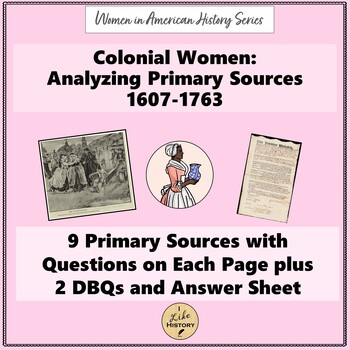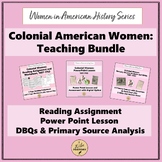Women in Colonial America: DBQs and Primary Sources *APUSH*
- PDF
- Easel Activity
Also included in
- This resource bundle includes the following items:*Colonial American Women: Power Point Presentation*Colonial American Women: Reading Assignment and Worksheet*Colonial American Women: Analyzing Primary Sources and DBQsPower Point LessonThis 22-slide PowerPoint presentation covers women's experiencePrice $6.30Original Price $9.00Save $2.70
- History comes to life for students when they read primary sources! This Early America Women's History Mini-Bundle will fascinate and engage your students. Each Primary Source Analysis and DBQ resource gives students a chance to delve deeper into life of women during the Colonial Era (1607-1763), tPrice $9.00Original Price $10.00Save $1.00
Description
This 21 page Primary Source Analysis and DBQ activity gives students a chance to delve deeper into life of colonial women from 1607 to 1763. They will be able to determine what issues were important to women and how they contributed to society. Included is a one-page sheet that explains what primary sources are and how to analyze them using specific questions through a process called HAPPY. Primary sources include pamphlet excerpts, photographs and posters. Each page of primary sources includes questions.
There are also two DBQ questions. DBQ questions are an excellent way for students to identify point of view, consider intended audience and context. DBQ practice helps students prepare for AP and IB exams.
There is also a page at the end for students to apply the HAPPY process to one source. An Answer Key to all the questions and the HAPPY process is available at the end of the packet. This is excellent practice for all high school students, particularly Honors and AP students, but all students will find these resources engaging.
Students can read this on their own as a homework assignment or it can be a group activity in a classroom. It is also ideally suited for home-schoolers or independent learners who want to learn more. Teachers can assign just a few sources to analyze or the entire packet. Student time will vary. A Worksheet with questions based on the reading is included, along with an Answer Key.
There is also an Easel Activity which allows students to answer the questions at the end of each primary source online. For homework purposes, Home Schoolers or for asynchronous learning, this is an especially valuable digital option .
This is part of the Women in American History Series which includes PowerPoint lessons as well as Reading Assignments and Worksheets, Analyzing Primary Sources and Activities for other eras.
If you like World War II historical fiction, I have written a book called Hearts of War about a Nisei soldier who served in the Military Intelligence Service and a woman who served in the Women Army Corps. In writing this book, I wanted to bring an unknown aspect of history to light. Available on Amazon or Kindle and I appreciate any reviews!
Thank you!
Christa Nonnemaker








